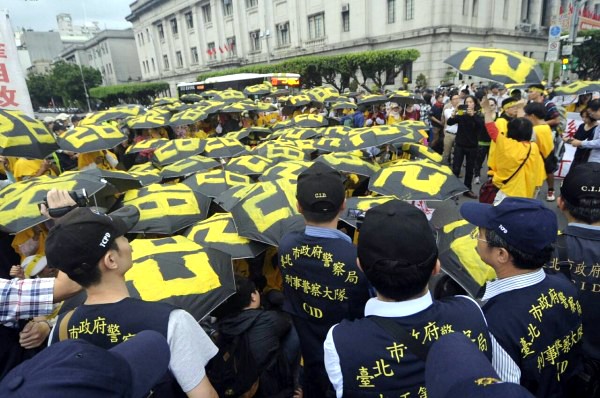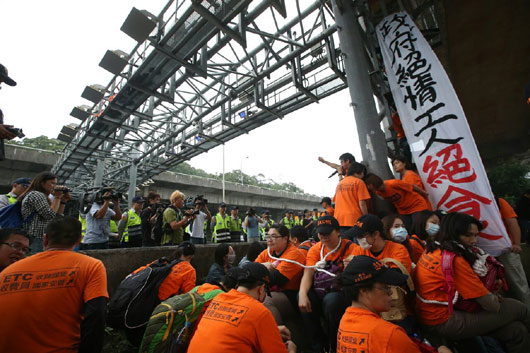On the Other Side of Nine-in-One Elections
by Brian Hioe
語言:
English
Photo Credit: 楊鵑如
ALTHOUGH AS was to be expected, media was mostly preoccupied with nine-in-one elections, the past month in Taiwan has been one marked by no shortage of activity by organized labor. In particular, this was driven on by two groups: the Former Toll Collectors’ Self-Help Organization and employees of Hualon Group.
The Former Toll Collectors Self-Help Organization consists of toll collectors laid off following the implementation of electronic tolling systems by the Ministry of Transportation and Communications (MOTC) in January, leaving 1,000 unemployed. Toll collectors were laid off with only seven months’ salary as a severance package because of their status as “contracted workers,” in spite of that workers had worked for years, or even decades. On the other hand, employees of Hualon group went on strike over the unscrupulous practices of Hualon Group, a textile manufacturer, which declared bankruptcy and asked workers to transfer at the cost of their pensions to Fung An Corp, a textile group thought to be a second firm created by the owners of Hualon. Retired Hualon employees also were in protest over unpaid pensions, with retired Hualon employees owed payments of 1 million NT each, or 33,000 USD, but of which 300 to 400 workers have received less than 60% of their promised payout.
The Highway Protest
NEITHER OF these two cases is especially recent. Former toll collectors held a six day occupation outside of the MOTC in June and carried out a theatrical act of protest in which toll collectors painted their faces blue and carried blue lamps while marching on Taipei’s National Sun Yat-sen Freeway No. 3. The blue emblems were to represent the blue light of the scanners on the electronic tolling machines they had been replaced by and, of course, as former toll collectors, it was also significant that the site of the protest was a highway. While succeeding in drawing attention from the broad consensus of Taiwanese civil society of students and citizen demonstrators that is normally active in social movements, especially because of the inventive nature of the protest action, the issue was not addressed by the government in any satisfactory manner at that time.
 Hualon demonstrators outside the Office of the President on October 10th. Photo credit: 廖振輝/Liberty Times
Hualon demonstrators outside the Office of the President on October 10th. Photo credit: 廖振輝/Liberty Times
On the other hand, Hualon workers held a surprise demonstration outside of the Office of the President in early October. But as Hualon workers have not been paid their full salaries since 2001 the problem is ongoing. The issue of unpaid workers after the company bankruptcy is also not new, seeing a series of demonstrations in 2012 after workers began to organize, with former Hualon employees beginning to organize under the mantle of the Hualon Self-Help Organization. Actions in 2012 included in June a one-month occupation of Hualon’s Toufen factory in Taoyuan, a campout in front of Taipei Main Station, and an attempt to blockade the home of Hualon owner Wong Da-ming that was met by police. June actions were followed by a march of over 100 kilometers from Toufen towards Taipei in August. Then-DPP chairman Su Cheng-chang expressed support and met with protestors at that point in time and the Ministry of Labor later intervened, negotiating that banks would donate NT$426 million to workers. This was the first time the Ministry of Labor had intervened in a dispute of this kind. Yet as this only accounted for 55 to 60% of the promised pay-off, demonstrations continued, and as current events goes to show, the issue remains unresolved.
Both groups expressed solidarity, coming together in a demonstration on November 20th. Both groups also pointed fingers specifically at the KMT government, with Hualon workers attempting to interrupt a KMT campaign rally attended by the KMT Taipei mayoral candidate Sean Lien and President Ma on November 13th. Likewise, former toll collectors stated that they would occupy National Sun Yat-sen Freeway No. 1 on November 28th, the day before nine-in-one elections and did so in a set of actions which included workers chaining themselves onto a bridge and scuffles with the police. This had been preceded by a hunger strike of four workers which lasted for over 200 hours. This was later carried out in an action which saw clashes with the police, but received lacking media attention in the shadow of nine-in-one elections.
The Future of Labor Post-Elections?
IN SPITE OF that the actions of both groups was meant to coincide with nine-in-one actions as a means of drawing attention, in retrospect we can conclude that the past month of labor actions were, in fact, overshadowed by nine-in-one elections. But what will the future of Taiwanese labor be, following the overwhelming defeat of the KMT in nine-in-one elections? Many have pointed to the historic nature of the defeat of the KMT in past local elections, seeing as that despite that Taiwan has see one DPP president in which the KMT was forced into the role of opposition, the KMT still generally retained control over local governments. The defeat of the KMT is, of course, indicative of growing dissatisfaction with the KMT across Taiwan at all levels following the Sunflower Movement.
 Members of the Former Toll Collectors Self-Help Organization occupying National Sun Yat-sen Freeway No. 1 on November 28th. Photo credit:余承翰/United Daily News
Members of the Former Toll Collectors Self-Help Organization occupying National Sun Yat-sen Freeway No. 1 on November 28th. Photo credit:余承翰/United Daily News
So far as the history of Taiwanese labor goes, Taiwanese history has always been marked by weakness—a weakness incurred by the brutal suppression of labor by the KMT during the Martial Law period. This was largely ignored by the world, with foreign observers sometimes pointing positively to the weakness or even non-existence of organized labor and attendant low production costs as a factor in Taiwan’s “economic miracle”. While the role of cheap labor in the Taiwanese “economic miracle” may or may not be true, as was the case with many of the “East Asian Tigers,” what foreign observers largely turned a blind eye to questionable practices. These were explained as quintessential cultural difference: in the case of Taiwan, the absence of any form of strong organized labor, in fact the product of the authoritarian regime of the KMT, was explained away as a product of Confucian social values.
Such is the traditional antagonism between the KMT and labor. So it is that labor is quick to point fingers at the KMT. But if Taiwanese labor has, in fact, always been weak, one speculates as to whether a future in which the DPP has won a number of significant victories will be better. As far before “democratization” as 1987, the DPP indicated a willingness to throw labor under the bus for greater interests, as demonstrated in a controversial series of comments by the DPP spokesman on labor affairs in which the DPP indicated to America that labor was not an issue in Taiwan—never mind that this was during a period in which labor still saw brutal suppression of the KMT government. This led to several split-offs from the DPP aimed at better representing worker’s interests in the late 1980s.
Did labor fair better once the DPP was in power, some two decades later? The DPP sought to sustain the support of Taiwanese civil society groups after coming into power and while civil society groups broadly might have fared better under a DPP than KMT government, increasing dissatisfaction with the DPP with the accommodation of the DPP to the political status quo saw groups becoming disillusioned with the DPP. The DPP was seen as having failed to usher in the sweeping change to Taiwan’s political system that it had promised. Though the DPP was still suggested to be better than the KMT, an often heard accusation was that the DPP tended to side with management rather than workers. Likewise, DPP’s advocacy of privatization measures proved detrimental to the interests of unions.
And so the historic weakness of Taiwanese labor persists. That nine-in-one elections drowned out the past month of labor issues in the media is not surprising. But that the DPP itself has been largely silent in the last month regarding these two sets of demonstrations does not bode well for the future of Taiwanese labor either. Perhaps it may be that labor was just not a critical constituency that the DPP needed to win over this time around in elections, although the DPP was careful to secure the consensus of Taiwanese civil society which was also supportive of workers after Taiwanese civil society was foregrounded in the Sunflower Movement. The actions of workers targeting the KMT only serving to work in the interests of DPP, in which case the DPP may not find it necessary to represent worker’s interests if workers only target the KMT and not also the DPP.
However, if the past nine-in-one elections represent something new for Taiwanese politics writ large, so too, perhaps, can new avenues of possibility be forced open for Taiwanese organized labor. It may be that this is what is on the flipside, on the other side of the coin, of the electoral politics represented in nine-in-one elections. Demonstrations continue, former toll collectors protesting the cabinet reshuffle which occurred after the defeat of the KMT as doing little to address their woes with a demonstration held outside KMT party headquarters on December 3rd. Yet it is such that too little attention has gone to Taiwanese labor and its discontents.



